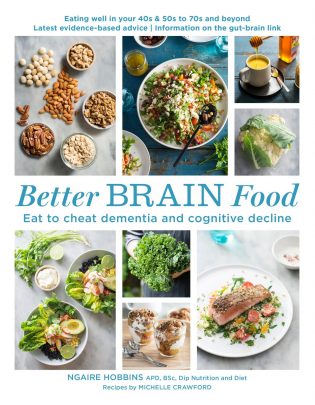
This publication is a gem. The cover catches one’s attention and although it contains so much information, remains uncluttered and promising.
It does not disappoint with glossy pages, beautiful appealing photos, occasional subtle woodgrain watermarks and clear font in black or very dark grey on white background. It seems to be a ‘fashion’ in some magazines and books to print on the coloured distracting background. Not so here on these clean looking, carefully designed appealing pages.
A very succinct, but must read foreword starts this factual volume. “The advice in this book is based on evidence uncovered so far by science about foods and ingredients that can help protect brain cells from damage….” This statement followed by several enlightening statistics and the author’s many qualifications convinces me that this will be very informative and worthwhile.

There are two distinct but related sections. Part 1 is the Science and Part 2 is the Recipes. Part 1 includes 9 chapters. Every word, phrase, and sentence is so instructive. However, in the space of this review, I feel compelled to mention the new and interesting facts. You will also, without doubt, find different sections ‘popping’ out at you. Some examples are; chapter 1 feeding your brain, “The key to brain health is not in any magic food or restrictive diet”. In chapter 2, understanding the brain, the facts on glia are so enlightening, “The second area of support the glia provide is in provision of resources for and protection of neurons, and in seeking out dead and damaged cells in the brain”. One is inspired to read more.
What you can change – eating to prevent dementia, eating for brain maintenance, gut health, obesity and diabetes, diet plans in the news and brain health through the ages are all illuminating chapters. Most of us know a little about most of these and some of the information written here will resonate (for example omega-3, antioxidants or serotonin). However, the clear, concise, science gives the reader a clearer understanding and extends or re-enforces knowledge. I particularly appreciate the chapter, brain health through the ages.
Part 2 commences with the pantry essentials, spices like cinnamon, turmeric, cumin, paprika nuts and seeds, grains, and pulses to name a few and, not to be overlooked, is what goes in the fridge.
Then there is ‘the toolkit’ (rather than equipment), essential in all good cookbooks. It includes basic cooking tools as well as basic mixed ingredients like spicy mixed seeds and sweet dukkah ready to use.
Now to more chapters; cooking for one or two, quick power meals, fast salads, more substantial meals, smart soups, snacks and drinks and the finale of fruit and sweet things. I have to single out red potato and ricotta pancake with smoked salmon and quick pickled radish, turmeric chicken with pumpkin and broccoli and roasted garlic, cauliflower and cheddar chowder. The illustrations of each dish are delectable (the photographer is expert), the page layout is clear and succinct and I love the suggestions or facts about each dish.
Add a few ingredients to your shopping list and you have so many ideas for quick nutritious meals in moments with nothing too complicated. As well is the certainty that you are giving your brain and body the best chance of good health.
The claim in small print on the cover “Eating well in your 40’s & 50’s to 70’s and beyond – latest evidence-based advice and information on the gut-brain link” is so scientifically based and so very convincing.
A book that must be close to hand in your meal preparation area and scheduled into daily living for the benefit of yourself and all whom you love.
Better Brain Food, by Ngaire Hobbins and Diet Recipes, by Michelle Crawford, is published by Murdoch Books